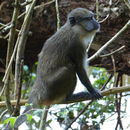en
names in breadcrumbs


Studies from the Lomako Forest in Zaire suggest that A. nigroviridis, like other Lomako Forest monkeys, is under a substantial amount of pressure from predators. These predators include the crowned hawk eagle, snakes, and pygmy chimapanzees. In response to these predators, many cercopithecids form poly-specific groups in the various forest types (McGraw 1994).
Perception Channels: tactile ; chemical
IUCN Red List of Threatened Species: least concern
Many cercopithecids, including A. nigroviridis, are hunted for their meat, and they are used in the biomedical research industry (Lawlor 1979).
Little is known about the overall natural history of A. nigroviridis; however, it is known that they forage on the ground and in shallow water (Walker 1975). The diet of A. nigroviridis includes fruit, leaves, and small invertebrates. http://www.zooregon.org/cards/monkey.allens.swamp.htm
Animal Foods: insects
Plant Foods: leaves; fruit
Primary Diet: omnivore
The range of Allenopithecus nigroviridis is from the Upper and Eastern basins of the Congo to Western Zaire (Walker 1975).
Biogeographic Regions: ethiopian (Native )
Studies from the Lomako Forest in Zaire suggest that A. nigroviridis is found only in the swamp forests. This differs from many other cercopithecids in that region, which occupy primary, secondary, and Mbau forests. The species is arboreal and at least semi-terrestrial (McGraw 1994).
Terrestrial Biomes: forest ; rainforest
These primates are thought to live up to 20 years.
Average lifespan
Status: wild: 23.0 years.
Other Physical Features: endothermic ; bilateral symmetry
Average mass: 4702.5 g.
Again little is known about the specific reproductive system of A. nigroviridis. Like other cercopithecids, females generally give birth to one offspring at a time. The young are typically weaned at 2.5 months (Hayssen and Van Tienhoven 1993). The length of estrus and menses is unknown as well as the breeding season. Allenopithecus nigroviridis can live up to 2 decades. ( http://www.zooregon.org/cards/monkey.allens.swamp.htm)
Average number of offspring: 1.
Average weaning age: 2.5 months.
Key Reproductive Features: iteroparous ; gonochoric/gonochoristic/dioecious (sexes separate); sexual ; viviparous
Average birth mass: 221 g.
Average number of offspring: 1.
Females nurse and care for their young for two and a half months.
Parental Investment: pre-fertilization (Provisioning, Protecting: Female); pre-hatching/birth (Provisioning: Female, Protecting: Female); pre-weaning/fledging (Provisioning: Female, Protecting: Female); extended period of juvenile learning
The Allen's swamp monkey (Allenopithecus nigroviridis) is a species of Old World monkey and the only member of the genus Allenopithecus. Phylogenetically, it is a sister clade to the guenons, but differs in dentition and habits.
Allen's swamp monkey was named after American zoologist Joel Asaph Allen.[3]
Allen's swamp monkey lives in the Congo Basin, in the Republic of Congo and in the west of the DRC. It was recorded from Dzanga-Sangha Special Reserve in the Central African Republic in 2016.[4]
This monkey is a rather strongly built animal. The slight webbing of the fingers and toes point to its partially aquatic way of life. Allen's swamp monkey can reach a full body length from 45 to 60 cm, with a roughly 50-cm-long tail. Males, weighing up to 6 kg, are substantially larger than the females (up to 3.5 kg).

Allen's swamp monkey is a diurnal animal and regularly looks for food on the ground. It inhabits swampy, water-rich areas and can swim well, diving to avoid danger. It lives in social groups of up to 40 animals, communicating with different calls, gestures, and touches.
Its diet consists of fruits and leaves, as well as beetles and worms.
Little is known of the mating habits of this species. The females bear young, which are weaned around three months old and are mature after three to five years. Its lifespan can be as long as 23 years. Raptors, snakes, and the bonobo are the natural predators of Allen's swamp monkey. It is also hunted for its meat.
The Allen's swamp monkey (Allenopithecus nigroviridis) is a species of Old World monkey and the only member of the genus Allenopithecus. Phylogenetically, it is a sister clade to the guenons, but differs in dentition and habits.
Allen's swamp monkey was named after American zoologist Joel Asaph Allen.